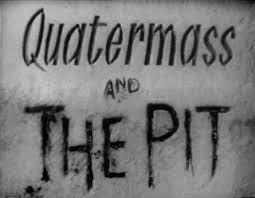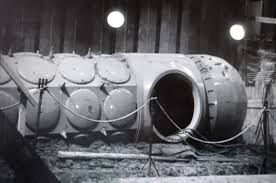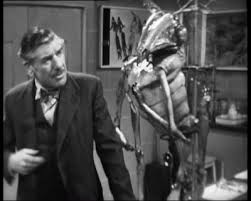IMDB metadata: 3 hours in six thirty-minute episodes, scored at 8.2 by 640 scorers. The plus sign (+) indicates it was shown in December 1958 and January 1959 on successive Friday nights.

Workers report finding human remains on a building site and a team of archeologists begin excavating the bones. Felix Leiter is a palaeontologist who leads the team and he needs publicity to delay the construction so that the remains can be carefully and fully removed in his own sweet time.
Meanwhile, Professor Quatermass is resisting attempts by the army to take over his missile experiments, but he is losing the ever so polite battle at the committee table.
Leiter calls a press conference and in the whirl runs into his old friend Prof Q. They compare troubles over brandy. The skulls are humanoid but not human. Are they the missing link, or that of the Twit in Chief?
Then the diggers come upon object, an object big enough and with the evident shape of a bomb, perhaps an unexploded bomb left over from the Little Blitz of V Rockets in1944. Down tools! In comes the UXB squad to do some more careful digging. Leiter fumes at being barred from his dig while the developer denounces the whole thing as a costly delay. By the end of the second episode anyone but a fool could see it is not a bomb, but Colonel Cardboard who has taken charge continues to insist, per the script, that it is German bomb. Unable to get his buddy James Bond, Leiter has called in Prof Q for moral support and together they do….research. This is not Indiana Jones country. This is thinking! Not punching.
They carbon date the remains and objects they find and they go to the library and archives to research the vicinity, Hob’s Lane. What do they find?
That the bones and skulls, though sort of humanoid, are five million years old. That makes them an odd fit for the chain of evolution as it was understood at the time outside Alabama, and for what it is worth, unlikely to be German. Not a single swastika was found. Moreover, they find that Hob’s Lane has a time-honoured reputation as a spooky place, with ghost stories going back to the Fourteenth Century and as recent as 1927 when the house adjacent to the building site was abandoned as unliveable because of…..’things.’ That got the attention of the fraternity brothers. ‘Things!’ They like things.
Meanwhile the Colonel has unearthed an object about the size and shape of a flying miniature submarine. There is much ill will between Colonel and Prof Q about what it is. They discover that it is not metal, as they know it. Nothing can penetrate it. Not an acetylene torch, not a diamond drill, not a split infinitive, not even the Twit in Chief’s ego. Colonel Cardboard’s solution is the soldier’s old friend, TNT. Prof Q goes all quivery and talks him out of it.
Finally, they find an open door on the other side of the gradually unearthed object and enter an empty vessel. The interior looks like a culvert, but the forward bulkhead is sealed off. Again they try to penetrate it with their penetrators. Then one after another a soldier and a safe cracker go spare while belabouring the bulkhead. Others will follow. Colonel is at a loss but cannot admit it. He puts it all down to a diet lacking moral fibre. Prof Q is turning his thoughts skyward. Leiter is counting his Loonies.
 The unexploded bomb of Colonel Cardboard’s dreams.
The unexploded bomb of Colonel Cardboard’s dreams.
The bulkhead has pentagrams on it. Whoa! Is it time for the occult? Then, seemingly of its own accord, the bulkhead opens. Inside they find……gargoyles!
The ship was clearly divided into two parts, a large compartment for passengers — those humanoids — and the sealed bulkhead wherein were found three deceased gargoyles on loan from Quasimodo. Huh? Moreover after careful examination the craft itself has no mechanisms. One officer, not Colonel Cardboard, speculates that the ship itself must be a mechanism of some kind. What a brew!
Quatermass does what scientists do best, speculate. He fumbles slowly to this conclusion. The gargoyles came from Mars five million years ago before life was extinguished on Mars. What were they doing? They were scooping up some of our simian ancestors, taking them to Mars where the Martians altered the simians by some means (surgical or biological), and then returned them to Earth. This find was but one of many such missions to alter the population of Earth.The other missions were successful but this one was not. Why they went to this trouble is not clear. This Martian intervention explains the missing link in human evolution. God does indeed work in mysterious ways because Martian insects made us human beings. Does that writer have a sense of humour or what?
This program of genetic engineering by the gargoyles was observed through the millennia five million years ago, and they were remembered in images of devils, satan, and other creatures that were the reality on which the gargoyles were modelled. First superstition and then religion arose against the reality of Martian insects.
 Prof with his favourite Martian.
Prof with his favourite Martian.
Meanwhile, Colonel Cardboard continues to yell about a German trick. Here the scriptwriter lets us down. Cardboard is so superficial it is impossible to take him seriously. But then the media begins to do what it does best, spread misinformation, panic, and hysteria. To hose it down, the Minister prefers the Colonel’s interpretation, and he makes sure he does not see for himself to keep his ability to deny reality in tact. That seems all to realistic.
Things go from stupid to disastrous when the minister decides, Colonel Cardboard being right, to hold a press conference on site and lay the whole story to rest as hoax. The energy of the crowd and the generators to power cameras, microphones, egos feeds the ship, which itself is some residual spectre, and things go flying.
Turns our Prof Q was right all along. It ends with his subsequent testimony laying out the story we have just seen.
It could not be made today. Bugs made humans. No God necessary.
There is much exposition across the episodes and each begins with a recapitulation of the story so far. It was re-made as ‘Five Million Years to Earth’ (1967). At feature length of 90 minutes this version compressed much with a faster pace.
It came from the fertile keyboard of Nigel Kneale, who has many noteworthy credits to his name, including the Quatermass franchise, ‘The Stone Tapes,’ and ‘The Year of the Sex Olympics.’
Skip to content
